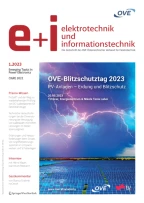Zusammenfassung
In diesem Beitrag wird zuerst eine elektromechanisch gekoppelte Theorie für dünne Schalen mit piezoelektrischen Wandlern im Rahmen einer geometrisch nichtlinearen Formulierung vorgestellt. Hierbei wird eine Schale als materielle Fläche mit mechanischen und elektrischen Freiheitsgraden modelliert. Eine Finite Elemente Implementierung beschließt den ersten Teil der Arbeit. Im zweiten Teil des Beitrags wird die vorgestellte Theorie mit Hilfe von Vergleichsrechnungen mit dem kommerziell erhältlichen Finite Elemente Programm Abaqus sowie mit Ergebnissen aus der Literatur verifiziert, um dann im dritten Teil der Arbeit zur Schwingungsreduktion zur Anwendung gebracht zu werden. Der vorliegende Beitrag endet mit einer experimentellen Untersuchung der passiven Schwingungsreduktion einer dünnen Schale mit piezoelektrischen Wandlern unter Verwendung der Methode des passiven Shunt Dampings.
Abstract
In the present paper a geometrically nonlinear electromechanically coupled theory for thin shells with piezoelectric transducers is presented. Within this theory the shell is modelled as a material surface with mechanical and electrical degrees of freedom. A Finite Element implementation completes the first part of the paper. In the second part of the paper the shell theory is verified by a comparison to results computed with the commercially available Finite Element code Abaqus as well as to results from the literature. In the third part of the paper the theory is applied to the problem of vibration reduction in thin shells with piezoelectric transducers. Simulation results and experimental results are presented, in which the method of passive shunt damping is used.
Literatur
Crawley, E. F. (1994): Intelligent structures for aerospace: a technology overview and assessment. AIAA J., 32(8), 1689–1699.
Tani, J., Takagi, T., Qiu, J. (1998): Intelligent material systems: application of functional materials. Appl. Mech. Rev., 51, 505–521.
Liu, S.-C., Tomizuka, M., Ulsoy, G. (2005): Challenges and opportunities in the engineering of intelligent structures. Smart Struct. Syst., 1(1), 1–12.
Nader, M. (2008): Compensation of vibrations in smart structures: shape control, experimental realization and feedback control. Linz: Trauner.
Alkhatib, R., Golnaraghi, M. F. (2003): Active structural vibration control: a review. Shock Vib. Dig., 35(5), 367–383.
Nestorović, T., Lefèfre, J., Gabbert, U. (2007): Model-based active noise control of a piezoelectric structure. Meccanica, 26(2), 71–77.
Gabbert, U., Tzou, H. S. (2000): Preface. In U. Gabbert, H. S. Tzou (Hrsg.), Proceedings of the IUTAM-symposium on smart structures and structronic systems, September 2000, Magdeburg, Germany. Dordrecht: Kluwer.
Krommer, M. (2003): The significance of non-local constitutive relations for composite thin plates including piezoelastic layers with prescribed electric charge. Smart Mater. Struct., 12(3), 318–330.
Batra, R. C., Vidoli, S. (2002): Higher order piezoelectric plate theory derived from a three dimensional variational principle. AIAA J., 40, 91–104.
Carrera, E., Boscolo, M. (2007): Classical and mixed finite elements for static and dynamic analysis of piezoelectric plates. Int. J. Numer. Methods Eng., 70(10), 1135–1181.
Zheng, S., Wang, X., Chen, W. (2004): The formulation of a refined hybrid enhanced assumed strain solid shell element and its application to model smart structures containing distributed piezoelectric sensors/actuators. Smart Mater. Struct., 13, 43–50.
Tan, X., Vu-Quoc, L. (2005): Optimal solid shell element for large deformable composite structures with piezoelectric layers and active vibration control. Int. J. Numer. Methods Eng., 64, 1981–2013.
Klinkel, S., Wagner, W. (2006): A geometrically non-linear piezoelectric solid shell element based on a mixed multi-field variational formulation. Int. J. Numer. Methods Eng., 65, 349–382.
Klinkel, S., Wagner, W. (2008): A piezoelectric solid shell element based on a mixed variational formulation for geometrically linear and nonlinear applications. Comput. Struct., 86, 38–46.
Marinkovic, D., Köppe, H., Gabbert, U. (2007): Accurate modeling of the electric field within piezoelectric layers for active composite structures. J. Intell. Mater. Syst. Struct., 18, 503–513.
Marinkovic, D., Köppe, H., Gabbert, U. (2008): Degenerated shell element for geometrically nonlinear analysis of thin-walled piezoelectric active structures. Smart Mater. Struct., 17(1), 10.
Lentzen, S., Klosowski, P., Schmidt, R. (2007): Geometrically nonlinear finite element simulation of smart piezolaminated plates and shells. Smart Mater. Struct., 16, 2265–2274.
Vetyukov, Y., Kuzin, A., Krommer, M. (2011): Asymptotic splitting in the three-dimensional problem of elasticity for non-homogeneous piezoelectric plates. Int. J. Solids Struct., 48, 12–23.
Naghdi, P. M. (1972): The theory of shells and plates. In S. Flügge, C. Truesdell (Hrsg.) Handbuch der Physik (Vol. VIa/2). Berlin: Springer.
Eliseev, V., Vetyukov, Y. (2010): Finite deformation of thin shells in the context of analytical mechanics of material surfaces. Acta Mech., 209, 43–57.
Vetyukov, Y. (2014): Nonlinear mechanics of thin-walled structures: asymptotics, direct approach and numerical analysis. Vienna: Springer.
Vetyukov, Y. (2014): Finite element modeling of Kirchhoff-Love shells as smooth material surfaces. Z. Angew. Math. Mech., 94, 150–163.
Pastor, M., Binda, M., Harcarik, T. (2012): Modal assurance criterion. Proc. Eng., 48, 543–548.
Varelis, D., Saravanos, D. A. (2002): Nonlinear coupled mechanics and initial buckling of composite plates with piezoelectric actuators and sensors. Smart Mater. Struct., 11, 330–336.
Ahmadian, M., Jeric, K. M. (2001): On the application of shunted piezoceramics for increasing accoustic transmission loss in structures. J. Sound Vib., 243(2), 347–359.
Hagood, N. W., von Flotow, A. (1991): Damping of structural vibrations with piezoelectric materials and passive electrical networks. J. Sound Vib., 146(2), 243–268.
Trindade, M. A., Benjeddou, A. (2009): Effective electromechanical coupling coefficients of piezoelectric adaptive structures: critical evaluation and optimization. Mech. Adv. Mat. Struct., 16(3), 210–223.
Zenz, G., Berger, W., Gerstmayr, J., Nader, M., Krommer, M. (2013): Design of piezoelectric transducer arrays for passive and active modal control of thin plates. Smart Struct. Syst., 12(5), 547–577.
Author information
Authors and Affiliations
Corresponding author
Additional information
Die Autoren bedanken sich für die Unterstützung durch die Linz Center of Mechatronics GmbH im Rahmen des COMET-K2 Zentrums ACCM und beim Fraunhofer Zentrum LBF sowie beim LOEWE Zentrum AdRIA in Darmstadt für die Unterstützung bei der Durchführung der experimetellen Untersuchungen.
Rights and permissions
About this article
Cite this article
Krommer, M., Pieber, M. & Vetyukov, Y. Modellierung, Simulation und Schwingungsreduktion dünner Schalen mit piezoelektrischen Wandlern. Elektrotech. Inftech. 132, 437–447 (2015). https://doi.org/10.1007/s00502-015-0375-5
Received:
Accepted:
Published:
Issue Date:
DOI: https://doi.org/10.1007/s00502-015-0375-5
Schlüsselwörter
- smarte Strukturen
- dünne piezoelektrische Schalen
- effiziente numerische Modellierung
- passive Schwingungsreduktion
